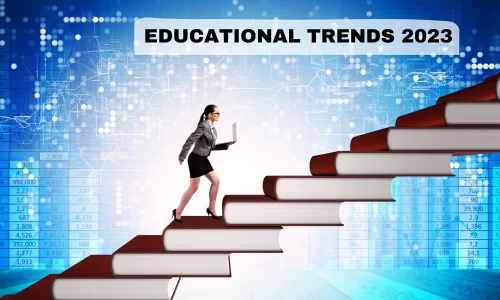Over the past two years, the edtech Industry has seen many uncertainties. The year 2022 has proven to be both challenging as well as brimming with opportunities.
At the end of 2022, we got a sneak peek of upcoming technologies, such as artificial intelligence, AR/VR, etc. At one point, we saw tremendous growth in the edtech industry, while at another, rising tuition fees and excessive screen time of students got us in a dilemma.
Now that we are into the first quarter of 2023, we are here to talk about the educational trends that are having a positive as well as negative impact on the edtech industry.
We will also take help from Evelyn’s industry report, “Trends and Forecasts on Learning Effectiveness in 2023”. In this report, many educational pundits, who have a rich experience of more than 15 years in the education industry, answered some questions regarding concerns affecting the e-learning industry and opportunities coming in 2023 to look forward to.
Edtech Industry Trends in 2023
During and after the pandemic, e-learning and blended learning started catching the limelight. They became more of a necessity rather than a luxury, as the pandemic refused physical contact completely.
In 2023, both these learning styles proved to have the biggest impact on the ed-tech industry.
Apart from this, AI has been in the news for the last few years. Just last November, OpenAI surprised us with ChatGPT and DALL-E 2. Let’s have a deeper look at all of these trends.
Artificial Intelligence
ChatGPT and DALL-E 2 have been in the news a lot since last year. OpenAI announced that more than a million people signed up for experimenting with this sensational chatbot. This chatbot has the potential to generate long-form content, extend longer conversations and compose, write song lyrics and educational content too.
According to Grandview Research, the real boost in the AI market was experienced after the year 2021. At that time, the size of the AI market was around $93.5 billion (USD).
During the last quarter of 2022, the AI market reached $136.65 billion, which is around a 50% increase from the previous year.
It is also estimated that by the year 2030, the market size of AI would reach $1,810 billion. A few decades ago, artificial intelligence was just a thought in progress. Now, we have robotics, machine learning, natural language processing, artificial neural networks, and whatnot.
Are robots going to replace humans as teachers?
In the next few years, it is believed that robots might have a certain level of self-awareness.
Some robots are humanized to some extent, like Sophia, the human-robot. Self-awareness means that there is no difference between a robot and human, which can also be concerning.
Sophia is a human-robot created by Hanson Robotics. Sophia uses some very advanced technologies, such as Natural Language Processing to understand human speech and Machine Learning to respond to human speech and gestures. This invention is the future of AI and one of the most advanced till date.
University and Startup Collaboration
Talking about industry-academia partnerships, in recent news, Jolly Good, a Japan-based startup has collaborated with Brigham and Women’s Hospital, which is affiliated with Harvard University. Together, they developed emergency care virtual reality content (VR).
Jolly Good medical VR solution will provide a more realistic experience than computer graphics. It will enable medical professionals to create their own live-action VR images.
Blended Learning
Coming to blended learning, this type of learning trend has not gained popularity only because of its sensationalism, but essentialism. Blended learning has become the most loved teaching method because it increases efficiency as well as student achievement by making them learn at their own pace. Apart from this, blended learning is also economical as well as time saving.
On the other hand, many people believe that hybrid learning leads to demotivation and procrastination. Also, it increases the screen time of students, making them feel lethargic all the time.
According to a report by NPR, 53% of children have their own smartphone at the age of 11.
In the year 2019, Common Sense Media found out that children aged 8-12 years spend almost 5 hours a day looking at the screen of their smartphones, tablets, and laptops. Moreover, teens aged 13-17 years spend around 7 hours a day doing the same.
Image Credit: National Education Association
Addressing the Challenges of the Education Industry in 2023
After talking about the useful trends in 2023, let’s move on to the concerns that we could be facing in the near future. The education industry has seen both bright and dull days.
“It cannot be denied that virtual technology is the future of education, but we also cannot agree that it would replace a physical presence”.
Are More Teachers Switching Professions?
During the pandemic, we saw teachers struggling with online teaching. They were feeling dejected, disrespected, and drained. The covid outbreak took a toll on most people’s mental health and online teaching did nothing, but added more mental fatigue to the already stressful life of teachers.
In the session 2022-23, many teachers stopped working. They either moved into non-teaching positions or switched schools.
School districts are unable to retain their teachers. Almost 50% of teachers transfer to new schools or worse, leave the teaching profession altogether. High school students as well as college freshmen have lost interest in teaching as a profession.
Image Credit: National Education Association
The above graph is a question from a research by Langer Research Associates asking parents if they want their children to pursue teaching as a profession. This question was first asked in 1969.
According to the U.S. Department of Education, 50 states in the United States reported a scarcity of teachers in the session 2022-23. There is a widespread shortage of special education teachers in 48 states, science teachers in 46 states, and math teachers in 44 states.
However, many education experts have also stated that the pandemic is just an excuse, and the problem of teacher shortage has been going on for more than a decade.
Teachers switching professions: The real reason
Cost of Education
Education is mandatory, but unaffordable. Many students who are willing to study opt not to continue their education because of the skyrocketing cost involved.
This concern was also highlighted in Evelyn’s industry report. Many experts highlighted this problem and agreed that the cost of education would continue to increase in the coming years too. As online learning is becoming more popular, the cost of education is also increasing.
“While we cannot deny the fact that technology has become an integral part of education, rising tuition fee is also a concern that the average American family is facing a lot”.
Cost of Education skyscraping higher than the previous sessions
The report of the College Board shows an immense increase in the average tuition fee of the private schools in the United States, such as Princeton University, Stanford University, etc.
The above graph shows the education cost, from the session 1992-93 to 2022-23. Although the tuition fee of public schools has declined slightly, keeping in mind the inflation, it is still expensive for lower-middle class families.
Reasons of Hike in Education Cost
In 2022, the cost of education was touching the sky. There are some reasons for this high cost of education . The important one is reduced state funding. In the academic year 2015-16, state funding declined by 11% compared to the last 10 years, which led to increased tuition fees.
This year, the trend has unfortunately continued and is now a big concern for students with poor pecuniary support. Students as well as parents are having second thoughts about pursuing a college degree.
According to the latest Forbes report, the number of students registering for college after high school has declined a lot. This year, college enrollment has decreased by 7% in comparison to the year 2017.
The reason is the sky touching tuition fee. Parents are thinking if taking a high debt for college education is worth it or not.
They are being skeptical regarding the value of a college degree. Students are starting to believe that colleges are overpriced and overrated.
Also Read: Should I go to college? We let our experts answer
Parental Involvement
Parental involvement is the participation of parents or guardians in a child’s education at home as well as in school.
Recently, we saw a lot of people inclining toward the idea of parental involvement in influencing school curriculums. They believed that this involvement leads to the growth and advancement of student.
Parental involvement in education is still a questionable thought.
In Evelyn’s 2023 ed-tech trends report, more than 50% of experts were in favor of the idea that parents should get involved in the decision making process regarding school curriculums.
However, other experts think that parents’ involvement leads to biased decision making. They consider that parents make decisions emotionally and not practically.
It is also believed by some pundits that educators make decisions by taking each and every student into consideration. On the other hand, a parent’s opinion might only be restricted to their child only.
Education Experts’ Opinions
In our recent Industry Discussion: Assessing New Age Curriculum Requirements with Jessica Aurilio and Alex Lochoff, we enquired if the involvement of parents in curriculum designing is valid or not. Their response to the question had some interesting points.
Jessica Aurilio is an edtech specialist at PowerSchool whereas Alex Lochoff is the director of curriculum at Edpuzzle.
Jessica said that curriculum development is not the area of parents to have a voice on. According to her, the idea should come from educators and people who are in the classroom.
On the other hand, Alex Lochoff was of the opinion that it might be okay to take suggestions from parents, but the parents should not have the decision-making power.
Watch the Full Webinar:
Conclusion
While we cherish the boost of artificial intelligence, AR/VR, and e-learning, we are also confused if this elevation is harmful for children. Students are having second thoughts about attending college, which is believed to be a foundational step towards career building. Increased screen time is not only harmful for physical health, but mental health too.
Parents must take measures to limit their children’s usage of technology. State should look into the matter of rising tuition fees. Awareness regarding scholarships and grants is required to provide education to every deserving student.
We have come a long way with technology. Many people are in support of e-learning. However, some think that traditional learning is still the most impactful way of learning. Both are correct in their own ways.
Everything has its pros and cons. Technology, if used correctly can turn out to be the best thing that ever happened to mankind. We should always look at the bright side of things.














